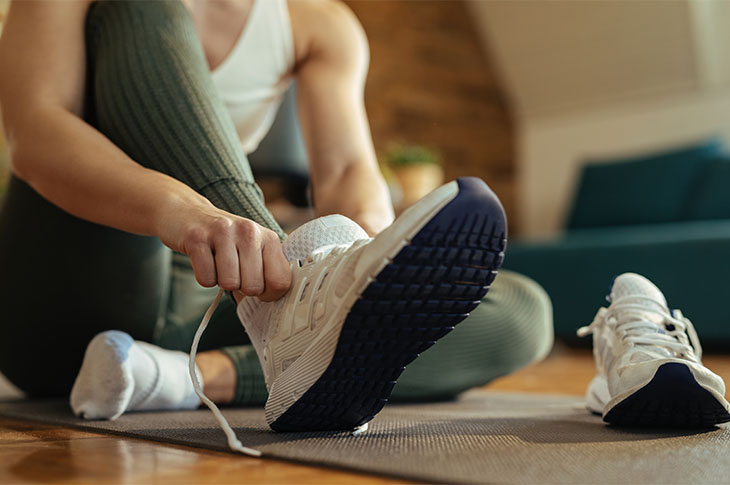
You show up to every Zoom meeting looking polished and professional—at least from the waist up—but your favorite fuzzy slippers have become a staple of your pandemic work-from-home attire.
Trading high heels for slippers might seem like a much-needed break for your feet, you may have traded one problem for another.
Even though high heels have been linked to foot pain, ankle injuries, and even toe deformities, Michael A. Schumacher, DPM, FACFAS, podiatric surgeon at Mount Sinai notes, “As people are spending more time barefoot or in flat, unstructured shoes [like slippers] during the pandemic, we’re seeing a lot more foot pain and injuries.”
Schumacher has seen a significant uptick in the number of cases of plantar fasciitis. Without adequate arch support, the facia, a thick band of tissue that runs from the heel to the toes, becomes inflamed and painful.
“By not [wearing shoes], you’re not supporting your foot, so you’re straining the plantar fascia with every step you take,” he says. “Untreated, pain lasts longer until it hurts all the time.”
Wearing supportive shoes with a low to moderate heel, thick soles, and good arch support can help prevent plantar fasciitis. If you develop the painful condition, podiatrist Dan Reubens, DPM, chief resident at Boston Medical Center, recommends rest, ice, and anti-inflammatories to help ease the pain; in more severe cases, orthotics or physical therapy may be required.
Going barefoot around the house also increases the risk of injuries. Reubens has seen a lot more fractured toes since the start of the pandemic, adding, “When you don’t wear shoes at home, you’re more likely to stub your toes.”
Fractured toes and lifted (and lost) toenails are especially common among those who are working out, barefoot, at home. During the day, skip the flip flops; although some may not want to wear shoes in the house all the time, consider lacing up a pair of sneakers for your workouts.
As the pandemic closed salons and DIY nail care became the norm, ingrown toenails became more common. In fact, Schumacher spent several telehealth sessions drawing diagrams to help patients with ingrown toenails properly trim their nails.
“People with chronic ingrown toenails who haven’t been getting pedicures are developing infections,” adds Jane Andersen, DPM, a podiatrist for Foot and Ankle Specialists of the Mid-Atlantic and spokesperson for American Podiatric Medical Association.
Foot pain could also be linked to weight gain, according to Andersen. Research shows that adults have gained almost two pounds per month during quarantine and the extra weight puts more strain on your feet, increasing the risk of foot pain.
Regular exercise—wearing sneakers, of course—to drop the extra pounds and continuing to wear shoes throughout the day are beneficial, if not essential to good foot health during the pandemic and beyond. Otherwise, Schumacher says, “You’re walking around reinjuring yourself by spending your time barefoot or in slippers or [shoes] that don’t support your foot at all.”
You may experience a different kind of foot pain when it’s time to slip your dress shoes back on and head back into the office. Andersen notes that corns, calluses, blisters, and metatarsalgia, pain in the ball of the foot, are all common complaints among women who spend a lot of time in heels. Until then, enjoy working from home in comfortable shoes.
This information is for educational purposes only and is not intended as a substitute for medical diagnosis or treatment. You should not use this information to diagnose or treat a health problem or condition. Always check with your doctor before changing your diet, altering your sleep habits, taking supplements, or starting a new fitness routine.

If you have questions about a Fitbit tracker, product availability, or the status of your order, contact our Support Team or search the Fitbit Community for answers.
Please note: Comments are moderated and may not appear immediately after submission.